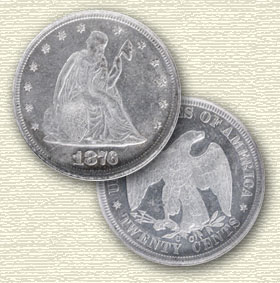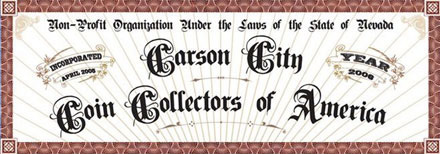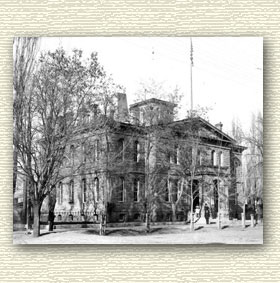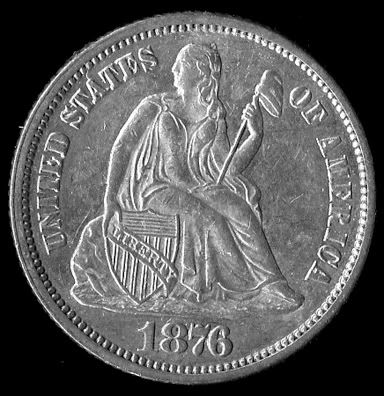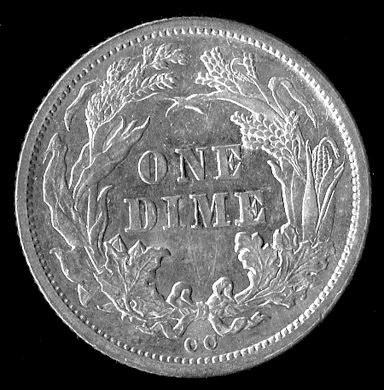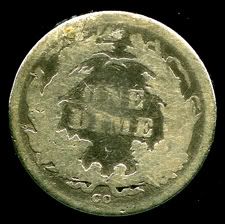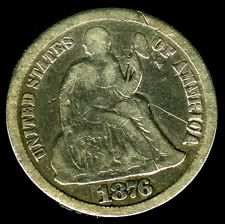- Posts: 614
- Thank you received: 0
1876-CC 10c – CC Coin of the Week – 10-19-2009
Less
More
16 years 2 weeks ago - 15 years 2 days ago #485
by Garryn
1876-CC 10c – CC Coin of the Week – 10-19-2009 was created by Garryn
1876 was a watershed year in American history. It was the country’s Centennial and the Centennial Exhibition opened on May 10. Rutherford Hayes was elected President, succeeding General U.S. Grant. The election of 1876 was a hotly contested affair. Hayes lost the popular vote to Samuel Tilden, trailed Tilden by 19 electoral votes with 20 votes from 4 states in dispute. All 20 were awarded to Hayes and he won the election by one electoral vote. Later, in 1878, President Hayes was presented with the first Morgan Dollar ever minted. It remans in his Presidential Library in Ohio.
There were two significant Indian skirmishes involving two former Civil War officers. One on June 25 at Little Big Horn, in the eastern Montana territory, where Sitting Bull and Crazy Horse with the Cheyenne, Arapaho and Lakota annihilated General George Custer and 5 Companies of his 7th Cavalry. A week before, the same Crazy Horse fought General George Crook at Rosebud Creek nearby. General Crook and his troops survived that but could not rearm and regroup in time to help Custer.
Though the Carson City Mint flourished under President Hayes during his administration, 1877-1881, he unsuccessfully vetoed the Bland-Allison Act, the government's first silver buying program. According to Q. David Bowers, he is quoted as saying "I think we should melt 700 of them [Morgan silver dollars] and make an Aztec Calendar for General John W. Foster." General Foster was then Ambassador to Mexico and a proponent of the Bland-Allison Act.
The Carson City Mint was in full swing in 1876. That year the Mint produced 8.27 million dimes, more than at any other time in their history.
The '76-CC dime has a little something for everyone. There were two reverses used. The Type 1 features a split ribbon on the left side. The Type 2 features a single pointed ribbon. There is also a doubled die obverse, with the Type 1 reverse, that Breen called “very scarce”. The letters “OF AMERICA” on the obverse exhibit some of the most significant doubling in US numismatics and visible to the naked eye in low grades. Included below are two pictures of my 1876-CC dime, doubled die obverse. If anyone has a better picture of the doubling, please feel free to add. And, hey, the [side-by-side] pictures worked!
There were two significant Indian skirmishes involving two former Civil War officers. One on June 25 at Little Big Horn, in the eastern Montana territory, where Sitting Bull and Crazy Horse with the Cheyenne, Arapaho and Lakota annihilated General George Custer and 5 Companies of his 7th Cavalry. A week before, the same Crazy Horse fought General George Crook at Rosebud Creek nearby. General Crook and his troops survived that but could not rearm and regroup in time to help Custer.
Though the Carson City Mint flourished under President Hayes during his administration, 1877-1881, he unsuccessfully vetoed the Bland-Allison Act, the government's first silver buying program. According to Q. David Bowers, he is quoted as saying "I think we should melt 700 of them [Morgan silver dollars] and make an Aztec Calendar for General John W. Foster." General Foster was then Ambassador to Mexico and a proponent of the Bland-Allison Act.
The Carson City Mint was in full swing in 1876. That year the Mint produced 8.27 million dimes, more than at any other time in their history.
The '76-CC dime has a little something for everyone. There were two reverses used. The Type 1 features a split ribbon on the left side. The Type 2 features a single pointed ribbon. There is also a doubled die obverse, with the Type 1 reverse, that Breen called “very scarce”. The letters “OF AMERICA” on the obverse exhibit some of the most significant doubling in US numismatics and visible to the naked eye in low grades. Included below are two pictures of my 1876-CC dime, doubled die obverse. If anyone has a better picture of the doubling, please feel free to add. And, hey, the [side-by-side] pictures worked!
Last edit: 15 years 2 days ago by Garryn.
Please Log in to join the conversation.
16 years 2 weeks ago #487
by LITAS
Replied by LITAS on topic Re:1876-CC Dime; CC Coin of the Week, Oct. 19, 2009
Please Log in to join the conversation.
Less
More
- Posts: 614
- Thank you received: 0
16 years 2 weeks ago #488
by Garryn
Replied by Garryn on topic Re:1876-CC 10c – CC Coin of the Week – Oct. 19, 2009
Not sure, but you might have one of each Type there, John. The AU58 looks like a Type 1 to me.
Please Log in to join the conversation.
16 years 2 weeks ago #489
by randysc
Replied by randysc on topic Re:1876-CC 10c – CC Coin of the Week – Oct. 19, 2009
What a nice touch to include a little bit of history of the year that the coin was minted. It enhances the story of the coin to know of a little bit of goings on the same year of the coin.
Also it is quite refreshing to see a coin posted that has seen some action. Good job, Garry.
-R.-
Also it is quite refreshing to see a coin posted that has seen some action. Good job, Garry.
-R.-
Please Log in to join the conversation.
Less
More
- Posts: 614
- Thank you received: 0
16 years 2 weeks ago #490
by Garryn
Replied by Garryn on topic Re:1876-CC 10c – CC Coin of the Week – Oct. 19, 2009
Thanks Randy, I got the idea from Belay Off and John. This section is really taking off!
Please Log in to join the conversation.
Time to create page: 0.120 seconds
